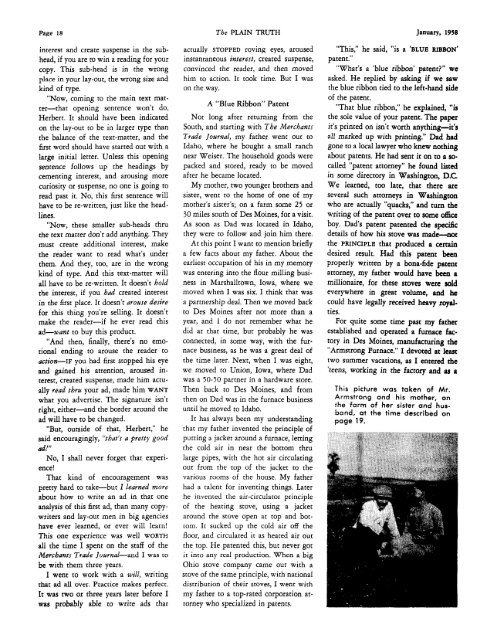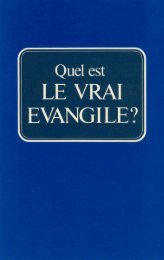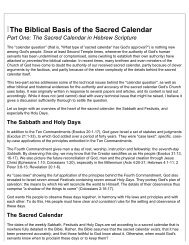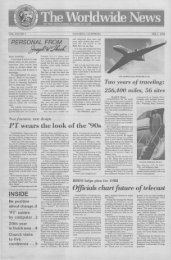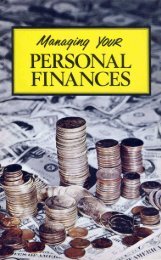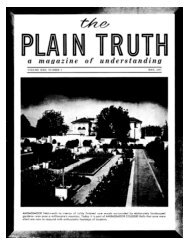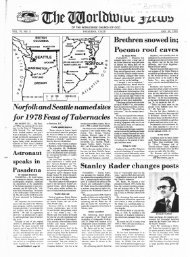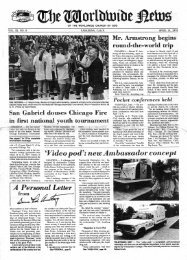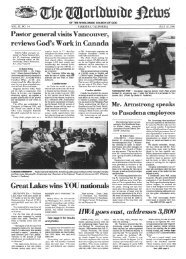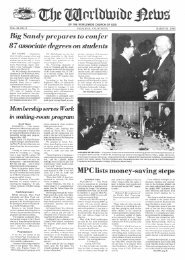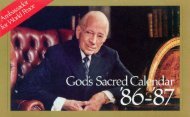Plain Truth 1958 (Vol XXIII No 01) Jan - Herbert W. Armstrong ...
Plain Truth 1958 (Vol XXIII No 01) Jan - Herbert W. Armstrong ...
Plain Truth 1958 (Vol XXIII No 01) Jan - Herbert W. Armstrong ...
Create successful ePaper yourself
Turn your PDF publications into a flip-book with our unique Google optimized e-Paper software.
Page 18 The PLAIN TRUTH <strong>Jan</strong>uary, <strong>1958</strong><br />
interest and create suspense in the subhead,<br />
if you are to win a reading for your<br />
copy. This sub-head is in the wrong<br />
place in your lay-out, the wrong size and<br />
kind of type.<br />
“<strong>No</strong>w, coming to the main text matter-that<br />
opening sentence won’t do,<br />
<strong>Herbert</strong>. It should have been indicated<br />
on the lay-out to be in larger type than<br />
the balance of the text-matter, and the<br />
first word should have started out with a<br />
large initial letter. Unless this opening<br />
sentence follows up the headings by<br />
cementing interest, and arousing more<br />
curiosity or suspense, no one is going to<br />
read past it. <strong>No</strong>, this first sentence will<br />
have to be re-written, just like the headlines.<br />
“<strong>No</strong>w, these smaller sub-heads thru<br />
the text matter don’t add anything. They<br />
must create additional interest, make<br />
the reader want to read what’s under<br />
them. And they, too, are in the wrong<br />
kind of type. And this text-matter will<br />
all have to be re-written. It doesn’t hold<br />
the interest, if you bad created interest<br />
in the first place. It doesn’t aTouse desire<br />
for this thing you’re selling. It doesn’t<br />
make the reader-if he ever read this<br />
ad-want to buy this product.<br />
“And then, finally, there’s no emotional<br />
ending to arouse the reader to<br />
action-IF you had first stopped his eye<br />
and gained his attention, aroused interest,<br />
created suspense, made him actually<br />
read thru your ad, made him WANT<br />
what you advertise. The signature isn’t<br />
right, either-and the border around the<br />
ad will have to be changed.<br />
“But, outside of that, <strong>Herbert</strong>,” he<br />
said encouragingly, “that’s a pretty good<br />
d!”<br />
<strong>No</strong>, I shall never forget that experience!<br />
That kind of encouragement was<br />
pretty hard to take-but 1 learned more<br />
about how to write an ad in that one<br />
analysis of this first ad, than many copywriters<br />
and lay-out men in big agencies<br />
have ever learned, or ever will learn!<br />
This one experience was well WORTH<br />
all the time I spent on the staff of the<br />
Merchants Trade JournaGand I was to<br />
be with them three years.<br />
I went to work with a will, writing<br />
that ad all over. Practice makes perfect.<br />
It was two or three years later before I<br />
was probably able to write ads that<br />
actually STOPPED roving eyes, aroused<br />
instantaneous interest, created suspense,<br />
convinced the reader, and then moved<br />
him to action. It took time. But I was<br />
on the way.<br />
A “Blue Ribbon” Patent<br />
<strong>No</strong>t long after returning from the<br />
South, and starting with The Merchants<br />
Trade jounzal, my father went out to<br />
Idaho, where he bought a small ranch<br />
near Weiser. The household goods were<br />
packed and stored, ready to be moved<br />
after he became located.<br />
My mother, two younger brothers and<br />
sister, went to the home of one of my<br />
mother’s sister’s; on a farm some 25 or<br />
30 miles south of Des Moines, for a visit.<br />
As soon as Dad was located in Idaho,<br />
they were to follow and join him there.<br />
At this point I want to mention briefly<br />
a few facts about my father. About the<br />
earliest occupation of his in my memory<br />
was entering into the flour milling business<br />
in Marshalltown, Iowa, where we<br />
moved when I was six. I think that was<br />
a partnership deal. Then we moved back<br />
to Des Moines after not more than a<br />
year, and 1 do not remember what he<br />
did at that time, but probably he was<br />
connected, in some way, with the furnace<br />
business, as he was a great deal of<br />
the time later. Next, when I was eight,<br />
we moved to Union, Iowa, where Dad<br />
was a 50-50 partner in a hardware store.<br />
Then back to Des Moines, and from<br />
then on Dad was in the furnace business<br />
until he moved to Idaho.<br />
It has always been my understanding<br />
that my father invented the principle of<br />
putting a jacket around a furnace, letting<br />
the cold air in near the bottom thru<br />
large pipes, with the hot air circulating<br />
our from the top of the jacket to the<br />
various rooms of the house. My father<br />
had a talent for inventing things. Later<br />
he invented the air-circulator principle<br />
of the heating stove, using a jacket<br />
around the stove open at top and bottom.<br />
It sucked up the cold air off the<br />
floor, and circulated it as heated air out<br />
the top. He patented this, but never got<br />
it into any real production. When a big<br />
Ohio stove company came out with a<br />
stove of the same principle, with national<br />
distribution of their stoves, I went with<br />
my father to a top-rated corporation attorney<br />
who specialized in patents.<br />
“This,” he said, “is a ‘BLUE RIBBON’<br />
patent.”<br />
“What’s a ‘blue ribbon’ patent?” we<br />
asked. He replied by asking if we saw<br />
the blue ribbon tied to the left-hand side<br />
of the patent.<br />
“That blue ribbon,” he explained, “is<br />
the sole value of your patent. The paper<br />
it’s printed on isn’t worth anything-it’s<br />
all marked up with printing.” Dad had<br />
gone to a local lawyer who knew nothing<br />
about patents. He had sent it on to a so.<br />
called “patent attorney” he found listed<br />
in some directory in Washington, D.C<br />
We learned, too late, that there are<br />
several such attorneys in Washington<br />
who are actually “quacks,” and turn the<br />
writing of the patent over to some office<br />
boy. Dad’s patent patented the specific<br />
details of how his stove was made-not<br />
the PRINCIPLE that produced a certain<br />
desired result. Had this patent been<br />
properly written by a bona-fide patent<br />
attorney, my father would have been a<br />
millionaire, for these stoves were sold<br />
everywhere in great volume, and he<br />
could have legally received heavy royalties.<br />
For quite some time past my father<br />
established and operated a furnace factory<br />
in Des Moines, manufacturing the<br />
“<strong>Armstrong</strong> Furnace.’’ I devoted at least<br />
two summer vacations, as I entered the<br />
’teens, working in the factory and BS a<br />
This picture was taken of Mr.<br />
<strong>Armstrong</strong> and his mother, on<br />
the farm of her sister and husband,<br />
at the time described on<br />
page 19.


